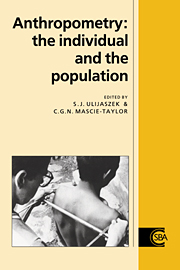Book contents
- Frontmatter
- Contents
- List of contributors
- Preface
- Acknowledgements
- 1 The place of anthropometry in human biology
- 2 Asymmetry and growth
- 3 Intra- and inter-observer error in anthropometric measurement
- 4 Statistical issues in anthropometry
- 5 Statistical constructs of human growth: new growth charts for old
- 6 Growth monitoring and growth cyclicities in developed countries
- 7 Growth monitoring, screening and surveillance in developing countries
- 8 Variability in adult body size: uses in defining the limits of human survival
- 9 Anthropometry and body composition
- 10 Anthropometry and physical performance
- 11 Anthropometry, strength and motor fitness
- 12 Anthropometry in the US armed forces
- Index
12 - Anthropometry in the US armed forces
Published online by Cambridge University Press: 19 November 2009
- Frontmatter
- Contents
- List of contributors
- Preface
- Acknowledgements
- 1 The place of anthropometry in human biology
- 2 Asymmetry and growth
- 3 Intra- and inter-observer error in anthropometric measurement
- 4 Statistical issues in anthropometry
- 5 Statistical constructs of human growth: new growth charts for old
- 6 Growth monitoring and growth cyclicities in developed countries
- 7 Growth monitoring, screening and surveillance in developing countries
- 8 Variability in adult body size: uses in defining the limits of human survival
- 9 Anthropometry and body composition
- 10 Anthropometry and physical performance
- 11 Anthropometry, strength and motor fitness
- 12 Anthropometry in the US armed forces
- Index
Summary
Military anthropometry in the United States has a long history, beginning at least as early as the Civil War, when such variables as stature, weight, and the body mass index (BMI) were utilized to identify recruits likely to be malnourished, tuberculous, or otherwise unfit for military duty (Ordronaux, 1863). The Civil War surveys also encouraged extensive investigation of the relationships between anthropometry and ancestry, birthplace, physiological measures, disease prevalence, and physical anomalies (Gould, 1869; Baxter, 1875). During World War I (WWI), stature, weight, BMI, pubic height, and chest circumference were utilized as indicators of fitness for load-carrying, marching, and fighting (Davenport & Love, 1921). Indeed, the nature and validity of relations between anthropometry and soldier health and physical performance continue to be a primary focus of military research, and they form the basis of many anthropometric standards for the selection and retention of individual military personnel (Friedl, 1992).
Whereas anthropometric standards for accession, retention, and occupational assignment are by nature applied to the individual soldier, it is the anthropometric variation of military populations as a whole that must be considered in the design and sizing of clothing, protective equipment, workstations, and other military hardware. The first US military survey to specifically address clothing sizing was conducted on approximately 100 000 separatees (soldiers discharged from service) at the end of WWI (Davenport & Love, 1921). By the end of World War II (WWII), gross incompatibilities between body size distributions and the workstations of major military hardware systems (such as the gun turrets of the B-17 bomber aircraft) had fuelled the application of anthropometry in the ever-growing field of human engineering (Brues, 1992).
- Type
- Chapter
- Information
- AnthropometryThe Individual and the Population, pp. 178 - 210Publisher: Cambridge University PressPrint publication year: 1994
- 5
- Cited by



